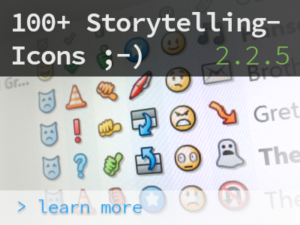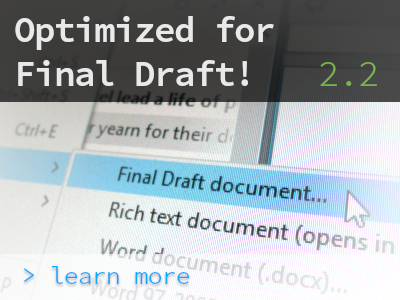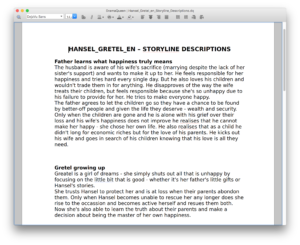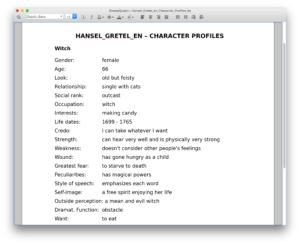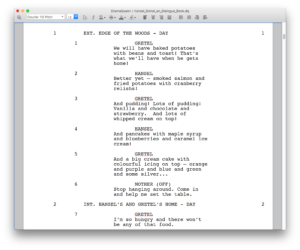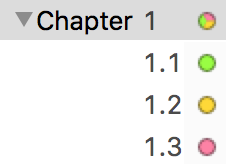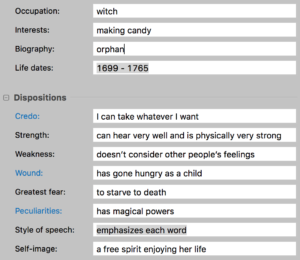We are very much delighted that our founding members Evi Goldbrunner and Joachim Dollhopf have won the German Film Award (Lola) for Best Children’s Film. :)
Archive | Blog @en
Update 2.2.5 with 100 New Storytelling Icons
We start the month of May with more than 100 new storytelling icons (for PLUS and PRO) in our new 2.2.5 update.
Everyone firing up their DramaQueen is offered the new update to 2.2.5. This one is packed with a large selection of new storytelling-icons that allows to easily tag the status, character emotion, dramaturgy and event of each scene:
DramaQueen 2.2 – and Preview of 2.3
In the weeks since our last release we have worked on two fronts: On version 2.2 and also on 2.3 in parallel. In the current update (2.2) we have focused on optimizing the workflow with Final Draft and improved on important usability details.
At the same time we have realized a good portion of our next big feature: Revision mode, which will make an appearance shortly in the form of the 2.3 update!
New in DramaQueen 2.2:
Optimized Final Draft workflow
Our goal was to optimize the workflow between DramaQueen and Final Draft in such a way, that working on the same document in Final Draft and DramaQueen alternately would not loose any layout information. This means each and every layout setting specified in a Final Draft document is imported into DramaQueen, such as the page margins, fonts, indentations and spacings. At the same time all layout information is exported to Final Draft as well as all learned words for spell-checking.
Usability
Several changes make for an improved handling:
- Quick navigation by remembering each caret position: DramaQueen will remember for each chapter or scene where the caret was last located in it. When typing at a certain position, then jumping to another scene in the document via the Outline panel and back again, the caret will be located at the exact same place as before. Not at the beginning of the scene any more. And to round this off, DramaQueen restores the exact last caret location when opening documents.
- Text notes may now also be sorted with the option ‘Oldest notes first’.
- The dynamic summaries may now be much longer. This makes sure that no room is wasted when showing the Outline fullscreen and with maximum column width.
- The thickness of underlines and strike-through lines adapts to the font size. Especially the spelling and grammar aid is much better visible as a result.
- The Character panel now offers a new attribute “Tactics”.
Here you can read a detailed update report for 2.2.
Preview: DramaQueen 2.3 with revision mode
The revision mode — many may know it as “Track changes” — is probably one of the most missed and therefore most often asked for features. All the more reason to close this gap sooner than later!
Since quite some time we have developed ideas and concepts. At the same time such an important tool shouldn’t deviate too much from the expectations of writers and how it is done in other applications — even just for compatibility reasons when importing and exporting. So the first step was to go back to all the suggestions, requests and requirements, that we received for the revision mode, and develop several very exciting concepts.
As a result, we are looking forward to offer a solution soon — intuitive to use as ever — which will combine the best and most powerful ideas to be able to meet all usage scenarios with great flexibility:
- Keeping track of different authors as well as revisions
- Automatic hover window and permanent tool stripe with all information for a given change and all action and navigation options
- Deleted text as pop-up
- Option ‘Track changes’ with pause-function
- Option ‘Mark as changed’
- Highlighting a changed line with a symbol (*) in the page margin – alternatively or in addition
- Revision text notes
Here is a first teaser-screenshot of our current progress:
We still need a little more time until the revision mode can be published in the next release, so it can — mature and perfectly integrated — satisfy the high expectations!
Multi-perspective Storytelling with DramaQueen
One of DramaQueen’s central ideas is to think of a story in individual storylines. Why is that so important? What do storylines do?
Storylines inspire me to go over my story several times. Because every strand has its own main character or the other way around: each character in their storyline is assigned their own conflict and development arc, their own antagonist and their own goal.
As a writer it is my job to experience my story through the eyes of each character. Within her storyline a secondary character becomes the main character. When, for example, the antagonist is seen as the protagonist of her storyline, it becomes clear that she also has a need and that her motive needs to be understandable and human. This change of perspective helps me to make my characters ambivalent and multidimensional.
Let’s look at one of the best known recent German films, “Good Bye, Lenin”:
The main character Alex wants to keep all excitement from his mother to save her life. But the other characters have their own goals too: Alex’ mother Christine faces the lie of her life in her storyline. Alex’ sister Ariane wants to start her own life with her own family and overcome the loss of her father. And Denis, Alex’ friend and colleague, wants to make great films as a director. Everyone has their very own understanding of what’s going on.
If you put all strands in relation to each other many stories turn into one. Every single one tells a part of the whole story – a different aspect, a different truth.
How can software make storylines identifiable?
That is the question we constantly ask ourselves. We’ve developed a method to develop the narrative arc of each storyline. Our storyline-modus creates a filter enabling you to dive into the world of a storyline and blank out everything else. The analysis graphic tool visualizes all storylines – for more see “What the narrative graph reveals about your story”. Our latest feature automatically structures a story into single storylines. Before you had to choose each scene separately to assign it to a narrative strand. Now all you need to do is to set up the central character constellation for each storyline. DramaQueen takes care of the rest…
DramaQueen 2.1 is out!
Three years after DramaQueen 1, we are very proud and happy to start into the second round with DramaQueen. To enable testing of the new features of DramaQueen 2.1 for all our users we have put a new trial period into DramaQueen 2!
New in DramaQueen 2.1: Facelift, Reports, Export, Sorting!
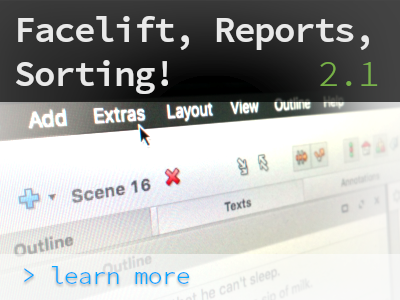
In our first release of the 2.x series, we have put the emphasis on optimizing the daily handling of DramaQueen and on laying the foundation for all nine comming feature updates of version 2. We have developed a new interface design for DramaQueen 2.1 which surprises with awesome, long wished for functions while at the same time making everything simpler and more intuitive.
Facelift / Dynamic Toolbar
Starting our new upgrade cycle, we have given DramaQueen a facelift. Our goal was to further reduce the elements of the interface. It shall step back behind the contents, the texts. The new dynamic toolbar replaces the local toolbars in the individual panels. It only shows the icons of the active panel which saves a lot of space and only needs a short time to adjust to:
Global Search Field
There is now a Quick Search which effects all panels equally. The search field is at the top right corner in the toolbar:

Overviews, Reports & Dialogue Book
The new main menu ‚Extras‘ contains options to generate various statistics, overviews, reports, and texts (for characters, locations and storylines):
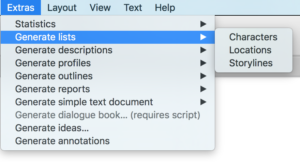
The generated texts open as separate dq-documents, e.g.:
This makes it possible to not only export these texts, but to also edit and save them. Copy & paste works, too, which makes it easy to prepend the script or novel with a character or location listing (by pasting the list into the pre-text). The layout can be changed before exporting as well.
For the dialogue book and the character reports the option exists to number the dialogue block, to generate them with or without parentheticals or do it only for selected characters:
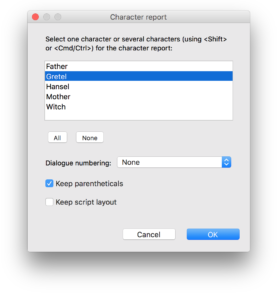
From the Extras main menu, it is also possible to generate simple text documents from the main texts, the three text levels:
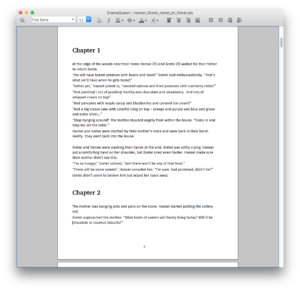
The great advantage of this new solution is at the one hand that one can send text in the dq-format to someone else, without giving away the entire project file with all its panel contents. On the other hand, the text can be layouted specifically before sending, without having to keep these layout changes when continuing to work on the text.
Expandable sub-chapters
In the Outline panel, the sub-chapters resp. the subdivided scenes are now expandable independent from the active text level. This makes them work exactly like chapters and scenes:
Convert chapter into sub-chapter
It is possible to convert chapters into subcapters and vice versa respective convert scenes in split scenes and vice versa. You can find the new options in the context menu of the outline and text panel:
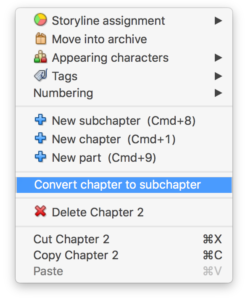
Separate storyline for each sub-chapter
Each sub-chapter may now be assigned its own storylines individually:
Sorting of ideas, characters, locations, and storylines
In the panels ‘Ideas’, ‘Characters’, ‘Locations’, and ‘Storylines’ there are now various sorting options available (via the gear-menu). The individual ideas, characters, locations, and storylines may be furthermore sorted manually per Drag & Drop:
Substantial improvements in exporting
- Limiting the text range: When exporting or generating a main text, there is now the option to limit the range to specific storylines, chapter or scene:
- Selecting elements: At the same time it’s now possible to generate / export single ideas, characters, locations, and storylines:
New fields ‘Live dates’ and ‘Speaking style’ in the Character panel
Multiple main windows & Duplicating panels
The ‘View’ main menu now features a sub-menu for the option “Open another main window”. This allows to select whether the new window shall be connected with the existing window (sharing the global selected element) or be its own independent window (with its own selection):
Also new in the View-menu: the options Duplicate panel and Fullscreen:
Here as always the Upgrade-Report for 2.1.
Download DramaQueen 2 now – with new trial period, free of charge and without restrictions:

What is next in DramaQueen 2
DramaQueen 2 includes 9 major releases (from version 2.1.0 up to and including 2.9.x.) with a plethora of new features and improvements. This will be those features that our users request the most, including the Top 10 most wanted features of our users:*
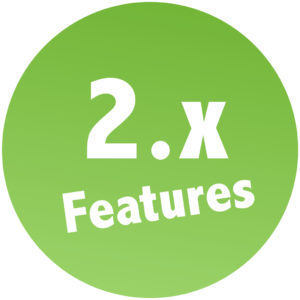
- the new features of DramaQueen 2.1 (see above)
- a revision mode to track changes and to compare different documents
- insertion of images
- the extension for theatre texts
- the possibility to plunge freely into writing, without forced decision for a type of text
- type writer mode
- and much more!
* Subject to unpredictible developments we reserve the right to exchange single features.
Upgrade to DramaQueen 2 here!
Recent Posts
- Your FAQ on AI integration
- DramaQueen 3.4: Flexible Levels & Fresh-up
- DramaQueen 3.3: One board for all purposes
- DramaQueen 3.2: Smart PDF export
- DramaQueen 3.1: Output and progress tracker
- Countdown to DramaQueen 3.0!
- DramaQueen 2.8: Footnotes & starting immediately: Purchase of Version 3!
- Inserting Images in DramaQueen 2.7
- On time for Christmas: DramaQueen 2.6 – References & Research
- DramaQueen 2.5: Plotting & Structuring
- Instant payment or Hire-Purchase?
- DramaQueen 2.4.5: Import templates
- DramaQueen 2.4: Story development
- DramaQueen 2.3 with revision mode
- More Ways to use DramaQueen
- Happy about the German Film Award LOLA!
- Update 2.2.5 with 100 New Storytelling Icons
- DramaQueen 2.2 – and Preview of 2.3
- Multi-perspective Storytelling with DramaQueen
- DramaQueen 2.1 is out!
- DramaQueen 2.0 with NOVEL extension
- 2.0.0 BETA 4
- 2.0.0 BETA 3
- 2015, 2016 and DramaQueen 2.0 BETA
- Open BETA program
- Storytelling in Storylines – an analysis of „Good Bye, Lenin!“
- What the story arcs reveal about your story – a check list
- New: DramaQueen now for Linux, too!
- What does ‘intuitive‘ mean? A look behind the scenes of DramaQueen
- Unique new tools for detecting, listing, sorting, and renaming characters!
- Hire-purchase
- New Download Server
- BETA 14
- What’s going on and what’s going to happen
- Noises from the basement
- We’re starting our English DramaWiki!
- BETA 10
- BETA 8
- DramaQueen for novel writers?
- BETA 7
- First Prospects
- BETA 5


